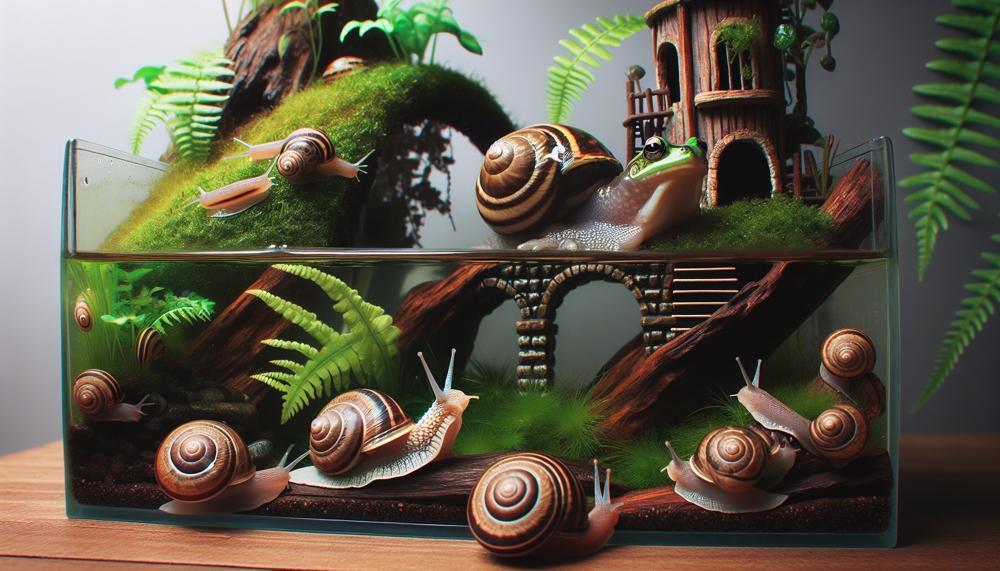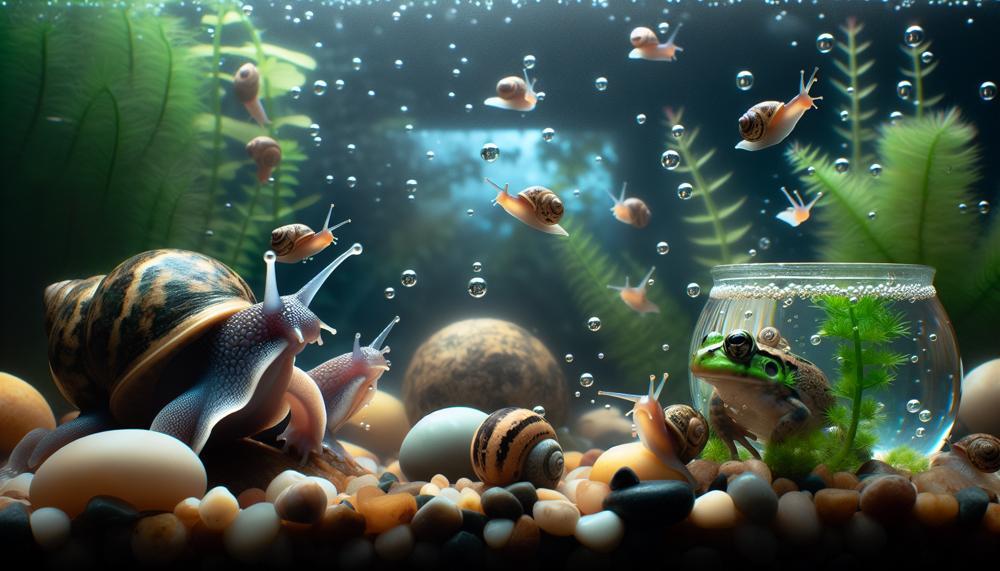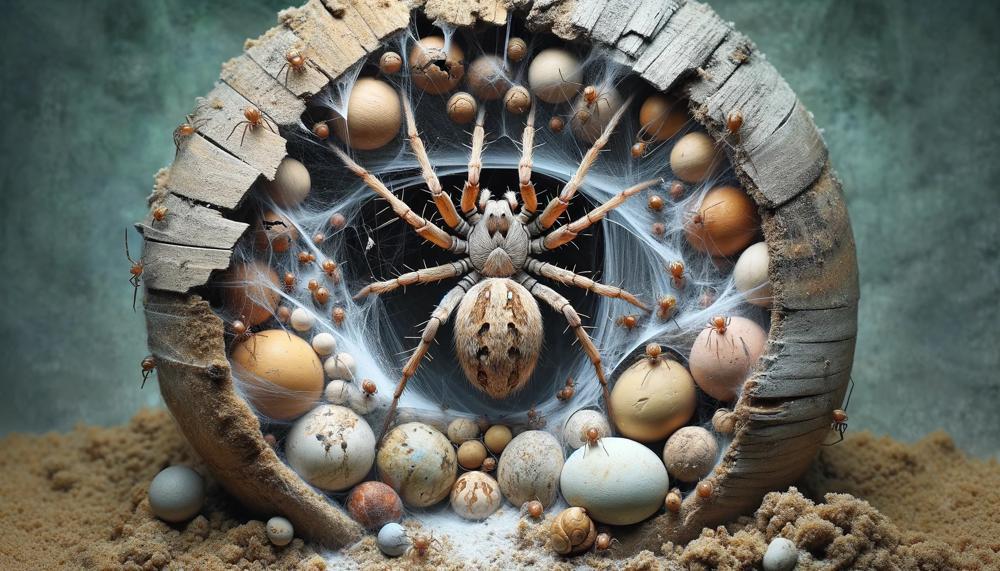Are you tired of the same old frog tank setup? Looking for a way to add some new life and diversity to your aquatic world? Then it’s time to consider adding snails as tankmates for your frogs.
These slimy creatures may not seem exciting. However, they can bring many benefits to your underwater ecosystem.
Snails and frogs can coexist in the same tank. Snails act as natural cleaners and create a more balanced environment.
- Snails serve as efficient cleaners, feasting on algae and other debris that can accumulate in the tank.
- They also help aerate the substrate, ensuring a healthy living space for your frogs.
- With a variety of sizes and colors available, snails can add visual interest to your tank.
- These low-maintenance creatures are perfect for beginner hobbyists.
- The addition of snails can promote overall health and well-being for all inhabitants by creating a more harmonious ecosystem.
So why not give these little mollusks a chance? Let’s dive deeper into how you can successfully introduce snails into your frog tank.
Table of Contents
- 1 Can I put snails in my frog tank?
- 2 The Danger of Uncycled Tank for the Snails
- 3 What is the Reason of Putting Snails in an Uncycled Tank?
- 4 Freshwater Snails That Can Survive in Uncycled Tank
- 5 Freshwater Snails That May Survive in Uncycled Tank
- 6 Freshwater Snails That Should Not be Put in Uncycled Tank
- 7 Conclusion
Can I put snails in my frog tank?
You should not put snails in a frog tank. Here are some reasons why:
- Snails eat frog eggs: Snails will eat frog eggs and, if hungry enough, will start on your plants.
- Frogs could eat the snails: Frogs are carnivores and will eat snails, slugs, and worms. If the frog is bigger than the snail and hungry, it will eat it.
- Mixing species is not recommended: Mixing species like frogs and snails is not recommended.
- Snails could carry parasites: Snails are invested with parasites which are easily spread.
- Snails could chew up plants: Snails will chew up every live plant you have.
The Danger of Uncycled Tank for the Snails
Snails in frog tanks face multiple risks due to inadequate cycling of the tank, including:
- Unstable water parameters: Newly set up or uncycled tanks fail to maintain crucial levels of ammonia, nitrite, and nitrate that are vital for aquatic animals’ survival. The build-up of these chemicals can be poisonous for both snails and frogs, causing stress, respiratory issues, and even death.
- Changes in water quality: Snails are highly sensitive to variations in their surroundings, especially when it comes to water quality. Any sudden changes in temperature, pH levels, or ammonia can be damaging and weaken their immune system, making them more vulnerable to diseases and infections.
- Competition for resources: In frog tanks, snails may compete with frogs for food and other essentials. This can lead to overfeeding and excessive waste production, resulting in spikes in ammonia levels that can harm both species.
- Parasites: Snails carry various parasites that can be harmful to frogs. Introducing snails into a frog tank without proper quarantine and treatment puts the frogs at risk of contracting these parasites.
- Rapid reproduction: Certain snail species reproduce at a rapid pace, laying multiple eggs at once. This can quickly lead to overpopulation in a small tank, causing water quality problems and competition for resources.
- Harmful interactions: Snails may attach themselves to the frog’s skin or gills, causing irritation and potential injury. This can be particularly problematic for young or weaker frogs, as they may not be able to defend themselves against the snails.
What is the Reason of Putting Snails in an Uncycled Tank?
When deciding whether to add snails to your frog tank, it’s essential to consider the tank’s cycled status. This is because uncycled tanks can harm snails’ health and survival.
Snails play a vital role in the nitrogen cycle of an aquarium, helping to maintain water quality and balance the ecosystem. However, they cannot single-handedly initiate or sustain the nitrogen cycle, which is where beneficial bacteria come in.
Beneficial bacteria are crucial for breaking down harmful toxins in an aquarium, such as ammonia and nitrites, which are produced by waste from fish, snails, and other aquatic creatures. In a cycled tank, beneficial bacteria convert ammonia into less harmful nitrites. The nitrites are then broken down into nitrates, which can be removed through regular water changes.
Snails contribute to the cycling process by producing ammonia through waste, providing a food source for beneficial bacteria. However, in an uncycled tank, there may not be enough beneficial bacteria present to handle the excess ammonia produced by snails. As a result, ammonia levels can quickly rise to toxic levels, causing stress and potential death for snails.
Adding snails to an uncycled tank can also disrupt the delicate balance of the ecosystem. Snails may compete with frogs for resources such as food and space, potentially causing harm or stress to both species. Additionally, uncycled tanks may contain harmful parasites or pathogens that can spread to snails and other tank inhabitants.
Therefore, it is crucial to properly cycle a tank before adding any animals, including snails. This means ensuring that there are enough beneficial bacteria present. The bacteria should handle the waste production of all tank inhabitants. Adding at least 5 snails to a tank provides enough ammonia for beneficial bacteria growth.
Freshwater Snails That Can Survive in Uncycled Tank
There are three primary varieties of freshwater snails that can thrive in an uncycled tank – apple/mystery snails, nerite snails, and ramshorn snails. These snails boast a remarkable ability to withstand varying water conditions and are renowned for their exceptional cleaning capabilities.
Yet, it’s crucial to regularly check the quality of the tank’s water and conduct routine water changes to maintain their well-being and avoid any potential problems.
The apple/mystery snail, also known as the mystery snail, is a fascinating creature. It can adapt to various water parameters. The fish can survive in an uncycled tank because of its exceptional respiratory system. This system allows it to breathe both in and out of water. This snail is a master at keeping the tank clean by consuming algae and excess food particles. This makes it a popular choice among aquarists.
Nerite snails are another type of freshwater snail that can thrive in an uncycled tank. These small but mighty creatures have high tolerance for varying water conditions. They are known for their exceptional algae-eating skills. They are also easy to care for and make excellent tank mates for other aquatic species.
Last but not least, the ramshorn snail is a resilient and hardy creature that can survive in an uncycled tank with ease. This snail is known for its unique spiral shell, which resembles a ram’s horn, hence its name.
This snail is an ideal choice for those looking for low-maintenance aquatic pets. It can survive in harsh conditions.
Freshwater Snails That May Survive in Uncycled Tank
Freshwater snails able to survive in an uncycled tank environment include bladder snails, Seminole rams-horn snails, tiger nerite snails, spike-topped apple snails, chocolate snails, red-rimmed melanias, black devil snails, assassin snails, great ramshorn snails, Japanese trapdoor snails, and island apple snails.
These species have adapted over time to thrive in different water conditions. With proper care and attention, they can continue to flourish in uncycled tanks.

| Snail Type | Scientific Name | Adaptability |
|---|---|---|
| Bladder Snail | Pomatias elegans | Capable of surviving in a wide range of water conditions due to their resilient nature. |
| Seminole Rams-horn Snail | Marisa cornuarietis | Able to tolerate fluctuating water conditions and low oxygen levels. |
| Tiger Nerite Snail | Neritina natalensis | Demonstrates a unique ability to thrive in both freshwater and brackish water environments. |
| Spike-topped Apple Snail | Pomacea diffusa | Adaptable to various water parameters and can even survive in stagnant water. |
| Chocolate Snail | Clea helena | Shows resilience in a wide range of water parameters and has the added benefit of consuming pest snails as a food source. |
| Red-rimmed Melania | Melanoides tuberculata | Exhibits a high tolerance for ammonia and nitrite levels in the water, making them ideal for uncycled tanks. |
| Black Devil Snail | Faunus ater | Can adapt to fluctuations in water conditions and has the added benefit of consuming pest snails. |
| Assassin Snail | Clea helena | Able to thrive in varying water conditions and can effectively control pest snail populations. |
| Great Ramshorn Snail | Planorbella duryi | Demonstrates resilience in both freshwater and brackish water environments. |
Freshwater Snails That Should Not be Put in Uncycled Tank
When considering which freshwater snails to add to your tank, it is vital to research the compatibility and needs of different species carefully. Some snails, such as Nerite, Mystery, Malaysian Trumpet, Rabbit, and Assassin snails, have a high bio-load. They also have specific dietary requirements. They are not suitable for uncycled tanks.
For example, Nerite snails and Mystery snails have a high bio-load. They need stable water parameters to thrive. They also have specific dietary needs. For Nerite snails, this includes sufficient algae or supplemental feeding. Mystery snails need sufficient calcium for shell growth. Rabbit snails also need stable water conditions. They need enough calcium for their shells to grow.
Malaysian Trumpet snails have no special requirements. However, they can potentially overpopulate a tank because of their high bio-load. If this occurs, they may need to be removed from the tank.
Assassin snails have a high bio-load. They also require specific prey (other snails). They do not have any special requirements. However, they may need to be placed in a separate tank if there is not enough prey present in the uncycled tank.
Conclusion
In conclusion, adding snails to your frog tank can bring many benefits. They can serve as natural cleaners and create a more harmonious ecosystem. However, take into account your tank’s cycling status before introducing these slippery creatures.
An uncycled tank can pose significant risks to snails. This includes unstable water parameters and increased chances of parasites. Also, there’s more competition for resources.
It is essential to properly cycle your tank before adding any animals, including snails. This ensures their overall health and well-being.
Some freshwater snail species can thrive in an uncycled tank with proper care and attention. However, Nerite snails, Mystery snails, Malaysian Trumpet snails, Rabbit snails, and Assassin snails may not be suitable. This is due to their high bio-load or specific dietary requirements.
Regular tank maintenance and cleaning are crucial. They keep pests away and provide a healthy habitat for your beloved frogs.





